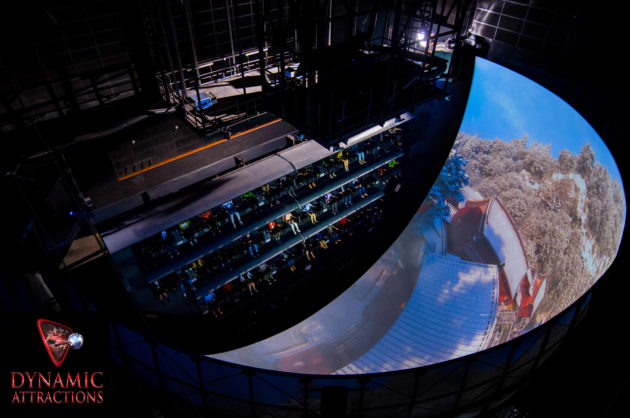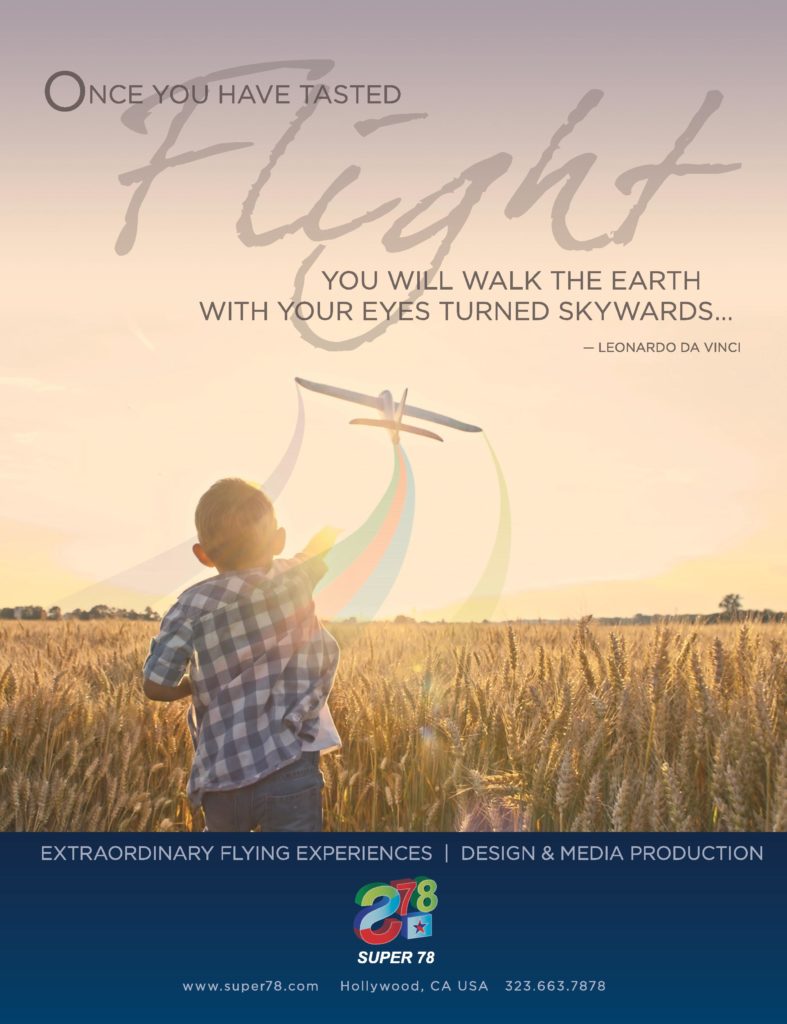The development and media of flying theaters
by Joe Kleiman
In 2001, Disney introduced a new kind of simulator adventure as a flagpole attraction at the new Disney’s California Adventure park at California’s Disneyland Resort. Guests encountered a fully themed environment stretching from a mountain airfield outside the building themed as a hangar, through graphics depicting the history of California’s aviation industry in the queue, and a pre-show with a flight captain preparing his passengers with a safety spiel. Once on board, the rows of seats rose up over a giant dome screen. Passengers, legs dangling, glided over the state of California, smelling the seas and the orange fields, the wind blowing in their hair.
The flying theater had been born. “Soarin’ Over California” proved so popular that Disney brought it to Walt Disney World in Orlando, adding two theaters to house the show at Epcot where, as one of the park’s highest-attended attractions, a third Soarin’ theater is being added to open this year.
COMPANION ARTICLES:
Ride Systems of Flying Theaters
“Flying Dreams” and the use of drones for flying theater media production
In fact, 2016 is the year Soarin’ is goin’ global at Disney parks. A new, internationally themed version, “Soarin’ Over the Horizon” will have its world premiere this season, first at the new Shanghai Disneyland, and shortly thereafter at Disney’s American parks, as “Soarin’ Around the World” (as the new version is titled outside of China). A fourth Soarin’ location was recently announced for Tokyo DisneySea.
As the popularity of Soarin’ grew, ride manufacturers, creative teams and attraction operators stepped up to build on the trend in various ways. Flying theaters have appeared around the world.
Some are operating as destination attractions, some within theme parks, and some in retail centers. They employ a variety of ride systems and degrees of freedom, theater configurations and in-theater effects, cinematic styles and storylines. Each is unique, highly integrated, technically sophisticated and dependent on close collaboration and creative teamwork for its success.
Characteristically, the flying theater utilizes an elevated seating platform, a partial dome screen and a customized AV and show control system. Riders hang suspended above a partial dome screen, able to see the action below, to the sides, and ahead toward the horizon. The screen is often truncated towards the top. Riders do not feel attached to a ride vehicle and begin to feel as if they are actually flying.
Rick Rothschild, who at the time as Senior VP – Executive Show Director at Walt Disney Imagineering, had been the Show Director on Soarin’ Over California – described the appeal of flying theaters. “There’s a raw response to flying over extraordinary places both known and not known, combined with a sense of actually flying, free from the Earth. This is why Soarin’ Over California is one of the most popular attractions in Florida.” Rothschild started his own company, FAR Out! Creative Direction, in 2008.
We explored a number of new flying theater attractions emerging on the landscape: Wings Over Washington, opening in Seattle this August; FlyOver America, opened in Minneapolis in April; Agila’s Flight, opening in Santa Rosa, Philippines this fall. We also looked at a new, turnkey flying theater package just coming on the market. Each offers a cohesive, themed experience from the queue through the pre-show and the ride itself. Each takes advantage of current digital technologies.
Wings Over Washington
Seattle’s Wings Over Washington, opening in August, is designed to give guests the illusion they’re up in the treetops on a platform looking at the stars – that is, until a bit of Native American magic lifts them up into the sky. The attraction sits on Pier 57, built in 1897 as Miner’s Landing, where the ships carrying gold from Alaska first arrived in Seattle. The pier is geographically at the center of a city plan to replace an elevated highway with a waterfront esplanade that will increase both tourist and local traffic.
The property’s owners, the Griffiths, are a famed local family of restaurateurs. Seeking a unique attraction to join the giant observation wheel they had installed on the pier, they approached Super 78 Studios, owned by Dina Benadon and Brent Young. Since the wheel already gives a bird’s eye view of Seattle, only one type of attraction could take their guests higher and farther.
The Griffiths knew they wanted a flying theater. Kyle Griffith, who is guiding the project with his father Hal, said, “Our vision was for an attraction that tells a thrilling and visually spectacular story about the physical beauty, history and culture of Washington. Super 78’s team created a complete experience that brought the vision to life, from the moment the guest walks in the door all the way through the exit.”
Wings Over Washington ties in thematically with a key design brief of the new Seattle waterfront: to link the city’s natural history and Native American and maritime heritage with today’s commercial and recreational opportunities.
As guests enter the 5-story building, a vast, topographical map of Washington State carved of wood lines one wall, part of the rustic theme throughout the attraction that pays homage to the state’s history and that of the pier. Audio and lighting cues highlight the points of interest that will be visited on the flight. On the opposite side of the room sits another wooden topographical map, this one highlighting the native tribes and reservations of the state. Guests proceed upstairs to the preshow and main auditorium.
The story is set in Washington’s Olympic National Forest. The preshow area holds 33 and is designed as a ranger’s cabin, with Native American design elements, including masks, and WPA-style posters. Lights dim and the posters rise up, exposing windows – actually video screens – on which a ranger appears and gives introductory information. The masks, built by Garner Holt Productions, articulate and vocalize to guests in rhythm with the musical score by Yessian Music, composer for the entire attraction.
As they sit and pull tight their safety belts (it is windy up in the treetops, after all), guests can see the forest and the night sky all around them, an illusion created through a combination of three ultraviolet murals of the Washington night sky devised and color corrected by GP Color Imaging.
The night sky begins to disappear, the seats rise up into the air and the wooden panels backing each row flip over to become canopies on the flying vehicle from Dynamic Attractions.
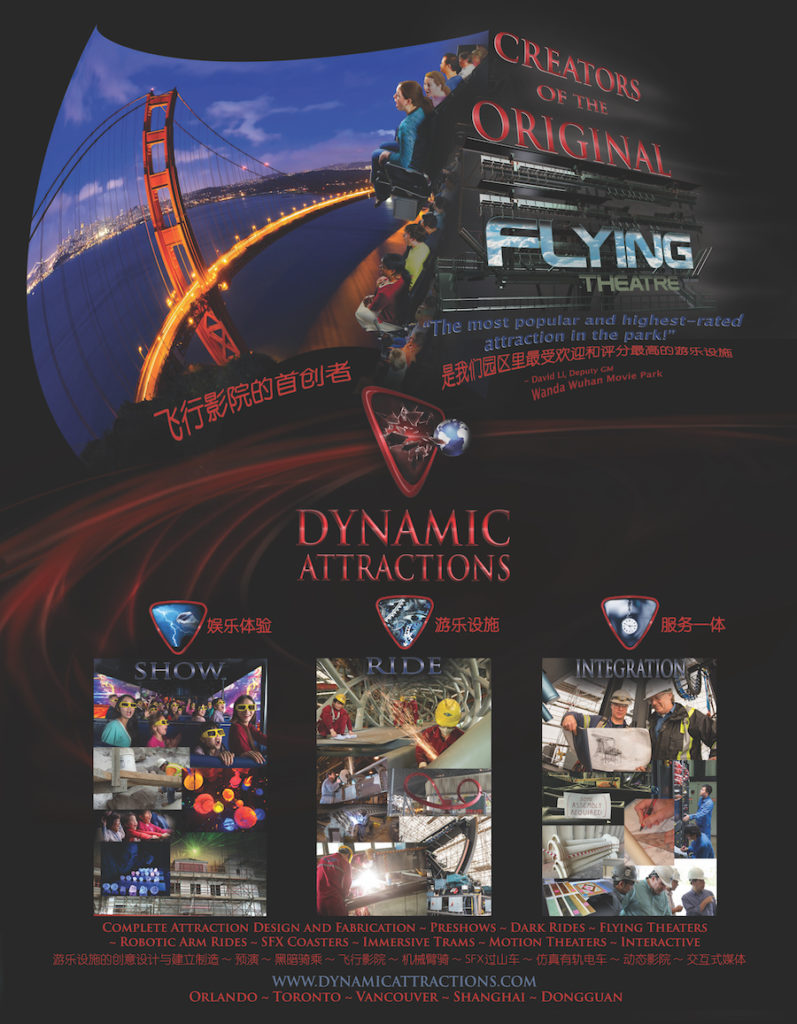 A totem pole with an eagle on top appears; the eagle magically becomes real and flies into the Washington sky, with the riders flying alongside. Soon, they are flying over well-known Washington landmarks, including a football game at the University of Washington, hot air balloons and wine grape fields in Walla Walla, and orcas in the San Juan Islands during the 5 ½ minute film. Each of these scenes drew on the visual effects acumen of Super 78’s team with other providers including Zoic.
A totem pole with an eagle on top appears; the eagle magically becomes real and flies into the Washington sky, with the riders flying alongside. Soon, they are flying over well-known Washington landmarks, including a football game at the University of Washington, hot air balloons and wine grape fields in Walla Walla, and orcas in the San Juan Islands during the 5 ½ minute film. Each of these scenes drew on the visual effects acumen of Super 78’s team with other providers including Zoic.
The crew was denied permission to film over Husky Stadium on the University of Washington campus during an actual game. The solution was to film an empty stadium and digitally add not only a football match in progress, but thousands of cheering fans in the stands. Super 78 was able to work off the original architectural plans for the stadium for accuracy.
With its proprietary Mushroom VR attraction design software, Super 78 was able to send virtual 3D mockups of the different sets, complete with media composited in, to the client during the design phase. The client was kept up to date on the production through viewings via an Oculus Rift VR headset that shared the media in a fully composed 360 degree environment.
Young had previously filmed two flying projects for OTC’s Happy Valley parks in China (see “China Cinema,” InPark Issue 41). “There were two big differences between that project and this one,” Young remarked. “On this one, we weren’t just making the film, we had full creative control of the entire project, and that made a huge difference in everything thematically coming together.Also, on Wings Over Washington, new technology meant we had a lot less gear, which freed us up creatively and of course, Mushroom helped me during the filming process.”
By creating a grid within Mushroom VR for the half-dome screen used in the ride, Young was able to pull the memory card directly out of the RED Epic once the helicopter or drone had landed and place it in a computer to view the newly captured footage as if he were in the theater on the ride.
Super 78 also devised methods for dealing with sound issues unique to the dome theater configuration. As the attraction uses a Christie 4K 6p laser projector mounted to a crossbar in front of the ride vehicle, it was important to minimize light loss. “Light loss tends to be around 30% on a perforated screen,” explains Young. “Our solution was to pinpoint where the individual speakers were to be located and then have Phoenix Rising, the firm responsible for the 39-foot diameter screen, create thousands of micro-perforations in the shape of kidney beans in front of each speaker. The rest of the screen remains solid.”
A/V integrator Electrosonic installed binaural speakers to the rear of each canopy, providing a two-in-one solution. As the canopy is folded over during the seating process, the speakers are housed under the chairs and emit the sounds of animals moving through the trees and the forest below, but once raised, they become personal rear channels for each passenger.
Super 78 reports being engaged on a number of flying theater projects currently in development stages.
FlyOver America
Inside the Mall of America in Minneapolis, Minnesota, a new entertainment offering, FlyOver America has been added to the mix of attractions and retail. This is the second flying theater attraction built by Soaring Attractions of Vancouver, Canada. In contrast to Wings over Washington, the attraction does not follow a narrative storyline, but is rather a more lyrical, immersive themed adventure.
During the development phase of its first flying theater attraction, FlyOver Canada, which opened in Vancouver in 2013, Soaring Attractions was already considering locations for a second flying theater. “We wanted something that would have both a high degree of foot traffic and a good mix of locals and tourists,” says Stephen Geddes, President of Soaring Attractions.
As with FlyOver Canada, Rick Rothschild of FAR Out! Creative Direction, whose clients include Walt Disney Imagineering, AOA and Thinkwell Group, served as creative director, with Dave Mossop reprising his role as film director. The film was shot by an in-house crew, with Geddes and Soaring Attractions CEO Andrew Strang executive producing the attraction. Joining the team were cinematographer John Trapman and composer Jacob Yoffee.
There were differences of location and physical space from one FlyOver to another. Vancouver’s is a standalone attraction within a popular downtown destination, Canada Place Pier, and a retrofit of an existing structure originally built to house a giant screen theater at Expo 86. Preexisting limitations were in place regarding the flow and design of the attraction.
FlyOver America is in an immense mall with other entertainment offerings adjacent, including a colorful Nickelodeon theme park. Architecturally, the spot chosen held an underutilized, live performance theater; that building was razed, and the Soaring Attractions team was able to work from scratch on devising a new structure and guest experience.
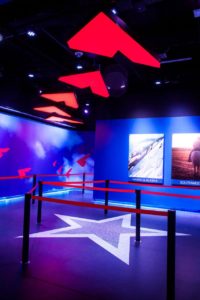 As FlyOver America is designed as an immersive, visceral adventure, not a narrative, rather than have a “first chapter” preshow, it was important to subliminally prepare guests for the main ride. With a theme park so close by, Rothschild also saw the need to create a deliberate transition. “We had to decompress our guests from the cacophony of the Nick Universe space,” he said. To accomplish these goals, the exterior architecture, queue, and preshow zones all are heavily invested with the paper airplane motif of the attraction, imagery of the US, and the sense of motion. “We’re giving the idea to our guests that they’re going to fly into the sky and see America.”
As FlyOver America is designed as an immersive, visceral adventure, not a narrative, rather than have a “first chapter” preshow, it was important to subliminally prepare guests for the main ride. With a theme park so close by, Rothschild also saw the need to create a deliberate transition. “We had to decompress our guests from the cacophony of the Nick Universe space,” he said. To accomplish these goals, the exterior architecture, queue, and preshow zones all are heavily invested with the paper airplane motif of the attraction, imagery of the US, and the sense of motion. “We’re giving the idea to our guests that they’re going to fly into the sky and see America.”
The main queue room is an elongated rectangle. Screens line the two long walls, each measuring 50 feet long and stretching 5 ½ feet from ceiling to head height. They undulate as an American flag in the wind. “Each of our regions is given a 3 ½ minute visual chapter that speaks to its aspect and breadth,” Rothschild explains, “The images are taken from the ground. We concentrate on three things – architecture, geometry, and people – of each region, and regional tunes play against each of the visual segments.” The video comprises a 22-minute loop, with guests averaging 12-13 minutes in the space. “On the busiest days, they’ll likely only see around half of the loop, so it gives them an opportunity to return and see what they missed.”
Sixty-two guests at a time enter the pre-launch area, a massive, three-story atrium with the stairs and balconies leading to the theater on one side and a huge floor-to-ceiling mural of the FlyOver paper airplanes soaring into clouds on the other. The lights dim and the safety video begins. “We had this huge space and we wanted to do something unique,” said Rothschild. “We took our cue from the creative airline safety videos that you now see in air travel. As we’re focusing on these different American regions, we decided to produce a music video, with different portions highlighted by different American regional music styles.” Motion 117 Productions of St Paul produced the video, with music produced by 6° Studios of Calgary, Canada. “We’re fortunate that with Minneapolis being such a strong theater and ad agency town, we had a lot of creative talent available for both production and performance.”
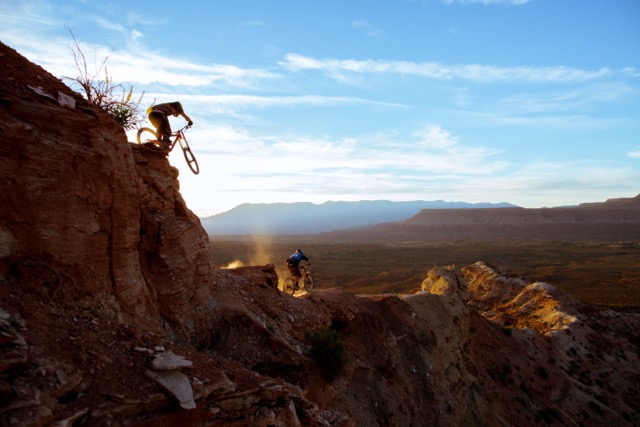
The 8-minute film begins in the clouds and ends in space over the Earth, viewing the entire US. “We were always on the lookout for neat looking clouds to film,” says Rothschild. “The final two locations are what we consider the two iconic entryways to the US – the Golden Gate Bridge, followed by the Statue of Liberty,” he adds. “We were fortunate that in our first location, the lighthouse off the Maine coast, there was a giant American flag flying on a flagpole, and then for our last shot, as we cross over the Statue of Liberty, there’s another giant American flag, reinforcing our theme.”
Brogent supplied the ride vehicles and dome screen, which is 66 feet in diameter and four stories tall. A/V integration was handled internally by Soaring Attractions, under the supervision of Eric Sambell. A Christie 4K Roadie projector is used in the main theater.

As others have, Rothschild has come across challenges with the rear audio channel in designing flying theaters. He employed on-board speakers. “The speaker locations behind the dome are the same as in Vancouver,” he explains. “Our big adjustment for FlyOver America is that each seat now has its own pair of stereo speakers hidden behind the mesh seatback. When speakers are mounted behind you in a theater, the sound is way behind you. We’ve fixed the issue by having the rear channel ride with you. Along with using them for sound effects, we were able to use these channels to bring the musical score off the screen, and we’ve improved the audio experience and made it more immersive.”
As they did with FlyOver Canada, Soaring Attractions engaged Rothschild to help create a holiday version of FlyOver America, where riders will search for Santa’s missing elves and enjoy an additional 92-second journey to the North Pole. “It’s the same film experience, except we overlay animation and provide a new ending. If you’ve never seen it before and want to, you’re still experiencing the FlyOver America you were expecting.And if you have ridden before, you can now enjoy it with a little something extra.”
Agila’s Flight
On the other side of the world, in Santa Rosa, Philippines, Enchanted Kingdom will soon open a flying theater with a conservation theme featuring the country’s national symbol, the eagle (agila in the native tongue Tagalog). Agila’s Flight (working name) represents the first major component of a five-year park expansion scheme. The goal of the new theater is to place Enchanted Kingdom on the international tourism map while providing an important and inspirational message to the more than 100 million residents of the Philippines.
Park Chairman and President Mario Mamon, a past president of IAAPA, forecast during a 20th anniversary celebration of the park that the new flying theater alone would pull in an additional million visitors per year, placing Enchanted Kingdom in the top 30 parks for attendance in the Asia-Pacific region.
The original concept had the eagle Agila as the central character,with riders soaring over the Philippines on its wings. Once production was underway, however, Mamon approached boutique design studio Rhetroactive to enhance the storyline and create a backstory for the attraction.
“We decided to feature Eldar the Wizard, Enchanted Kingdom’s mascot. Eldar was designed 20 years ago, but never had a strong presence inside an attraction,” said Steve Trowbridge, Creative Director on the attraction for Rhetroactive and co-founder of the studio. Now, the well-known character would act as guide and link the attraction with the rest of the park.
The storyline Rhetroactive devised revolves around the beauty and power of water, earth and air – the three essentials of Agila’s natural habitat. The guest’s role is to seek out these elements and restore their power. As guests proceed through the queue, they walk past three vignettes presented in forced perspective windows, each housing a crystal that contains the essence or soul of each element, symbolized in rear-projected images. Through additional effects and signage on the wall, the story unfolds gradually as guests proceed through the queue line. “We strove for a combination of simplicity and strong impact,” says Trowbridge.
Guests next pass into a pre-show room mocked up as an enchanted forest. Here, using technology provided by Holovis, Eldar appears via a fully realized 3D effect as a CGI character. He explains the importance of everyone being empowered so that Agila the eagle and all creatures, including humans, will have a beautiful place to live. Eldar then flies across the room and magically appears above the doors to the pre-board areas, reminding guests about the mission as he grants each the ability to fly. “It was important for us,” Trowbridge points out, “that we were not riding on the back of the eagle, but instead were flying with it.”
Trowbridge and his team wanted the concept of the three crystals to continue within the ride as a participatory experience. To that end, each guest receives a color-changing RF wristband, which interacts with the action on the screen. He explains that “This empowers the guests to connect with how their actions and behavior can influence the film. It produces a huge impact at low cost.”
The ride takes place inside a 105-seat SimEx-Iwerks SkyRide theater, one of the largest flying theaters installed, which, like FlyOver Canada, uses a 4K Christie Roadie projector. “On the busiest of days,” says Trowbridge, “the attraction can be turned around four times, with an hourly throughput of 420 people.”
The 6-minute film, directed by Manila-based Central Digital Lab, concentrates exclusively on the natural beauty of the Philippine islands and humans enjoying the natural world. The vast, 30-meter x 12-meter screen is flat with a slight curve (as one would find in a traditional giant screen theater) and mounted against one side of the auditorium, providing filmmakers the opportunity to include an underwater scene with turtles, rays,and scuba divers one would typically not expect to see in a theater with a dome screen beneath riders’ suspended legs. Note that unlike the other flying theaters described here, this one utilizes a flat instead of dome screen.
The musical score was composed by popular composer Ryan Cayabyab, known throughout the Philippines as a judge on several music competition TV shows, and for bridging the cultural gap between classical and modern pop music in the country.
Drone technology was essential to the new ending Rhetroactive created for the film. Trowbridge explained how. “In the original concept for the attraction, you took off over the Philippines and then landed at the park gate, without much fanfare. Those shots were filmed using a crane. We took an eight-mast drone with a 6K RED Epic camera attached and filmed a new ending at the park – a celebration of the Philippines, featuring 300 dancers and 700 extras. We would not have been able to do that without a drone strong enough to carry that camera.”
A primal experience
Fifteen years after its introduction by Disney, the flying theater has proven itself to be a versatile attraction, allowing riders to experience the world in a way they never could on solid ground. Flying theaters have a place among the family of observation attractions that are so popular nowadays, providing the experience of flight without actually taking passengers into the sky.
“The urge to fly is something everybody shares,” explains Brent Young. “It’s a dream we all have. And we feel like we are so close to being able to do it. We jump on trampolines, ride roller coasters, do all kinds of things that approximate that sensation. Flying theaters are primal wish-fulfillment no matter how old you are or where you’re from.”
• • •


